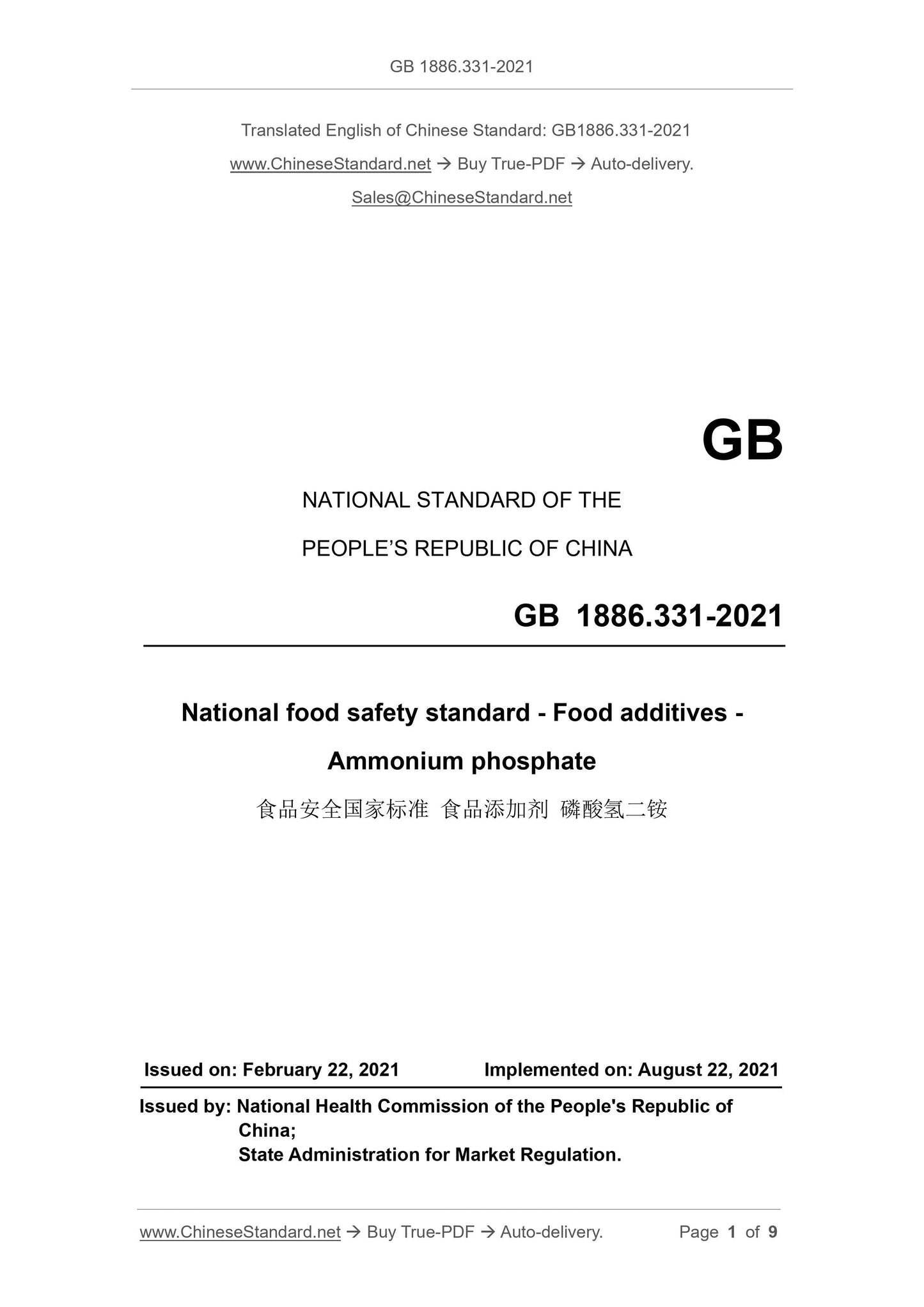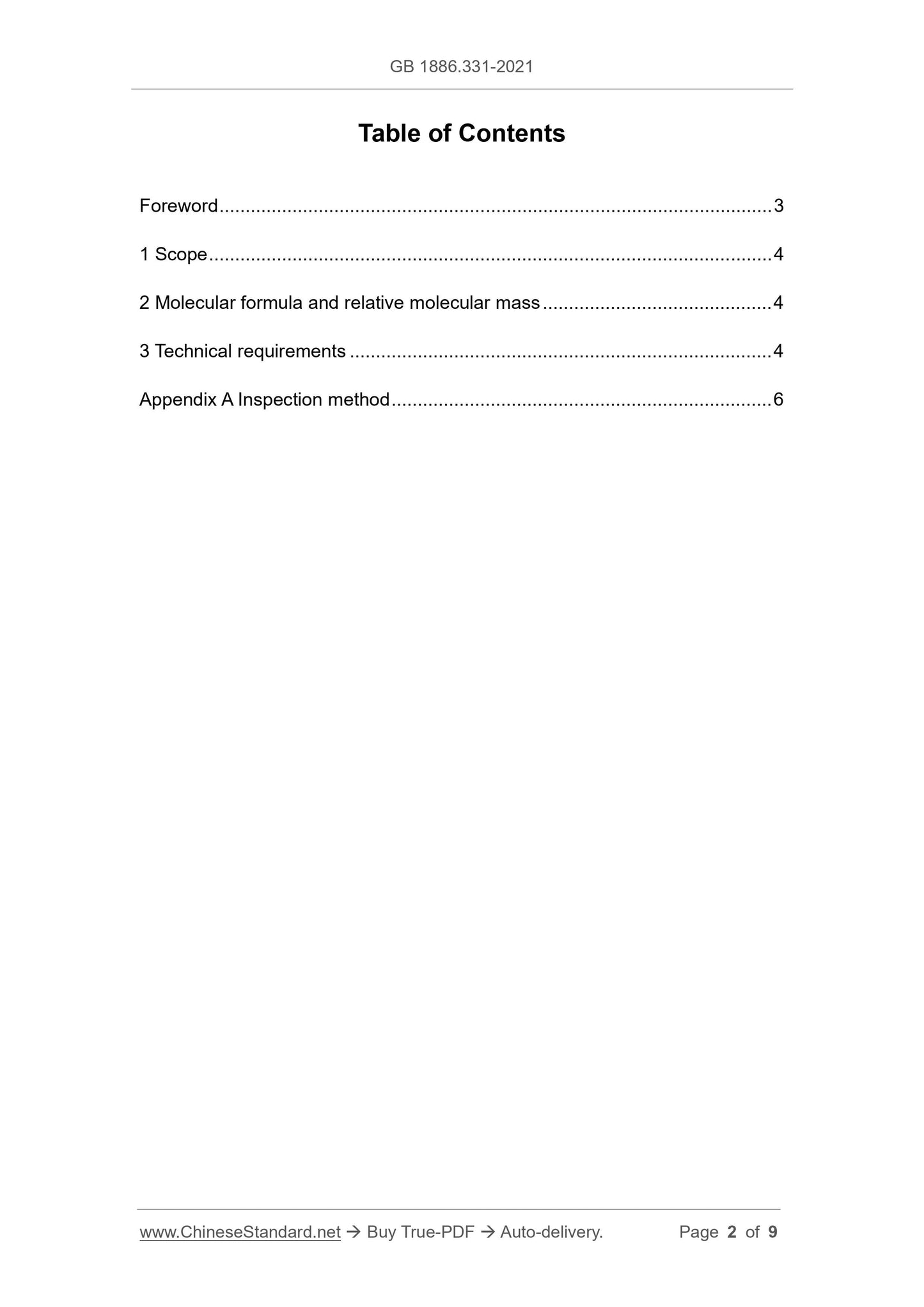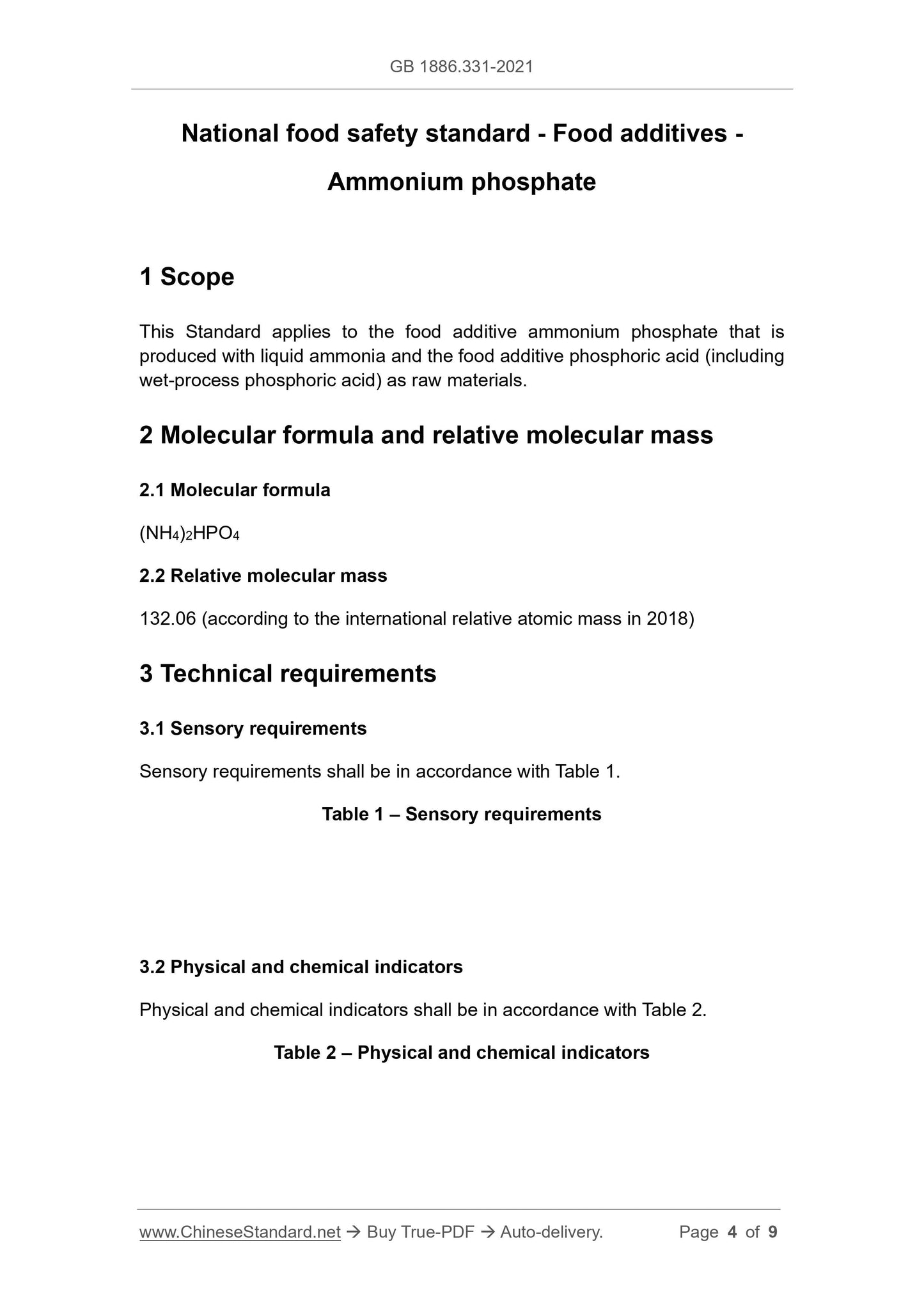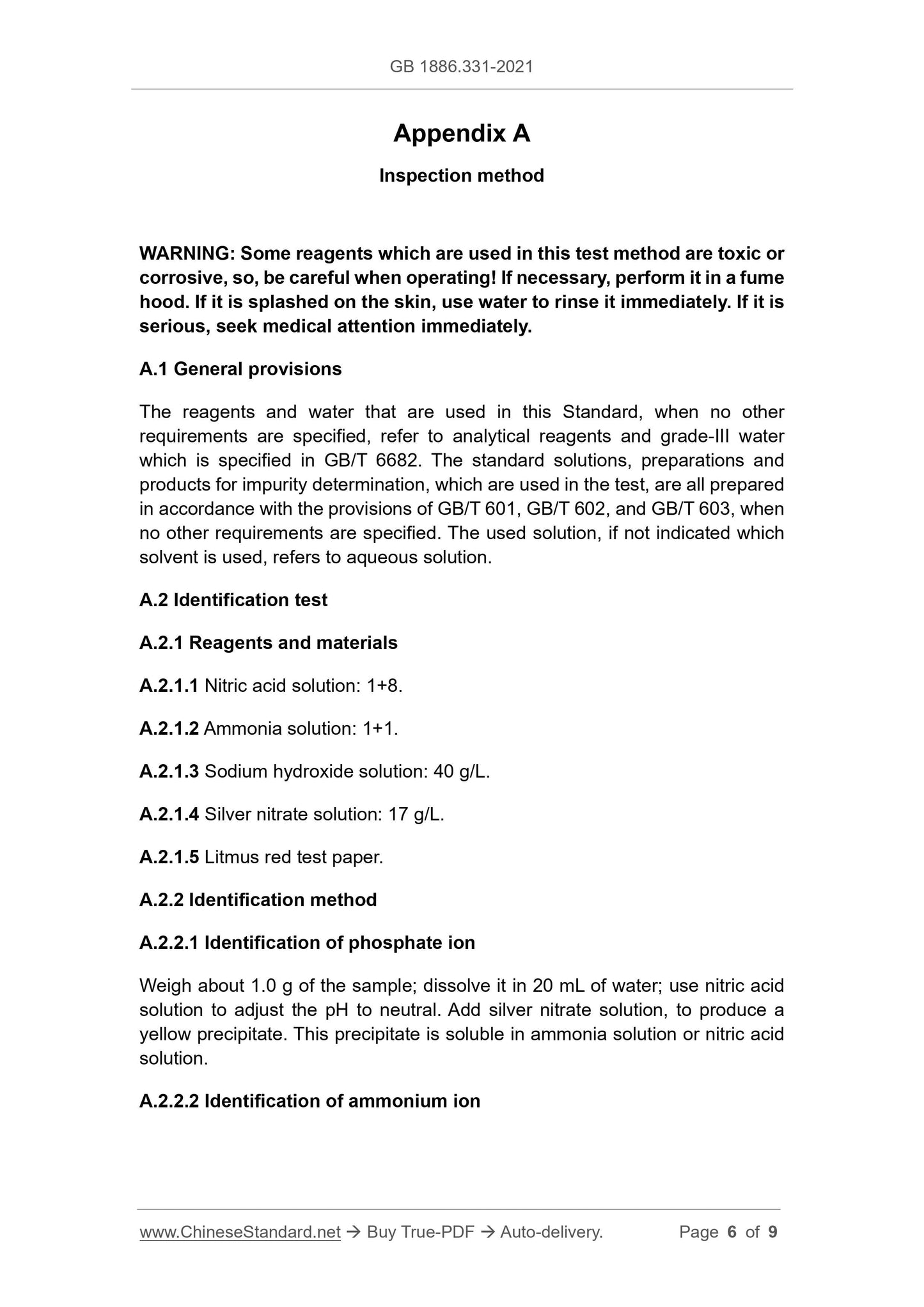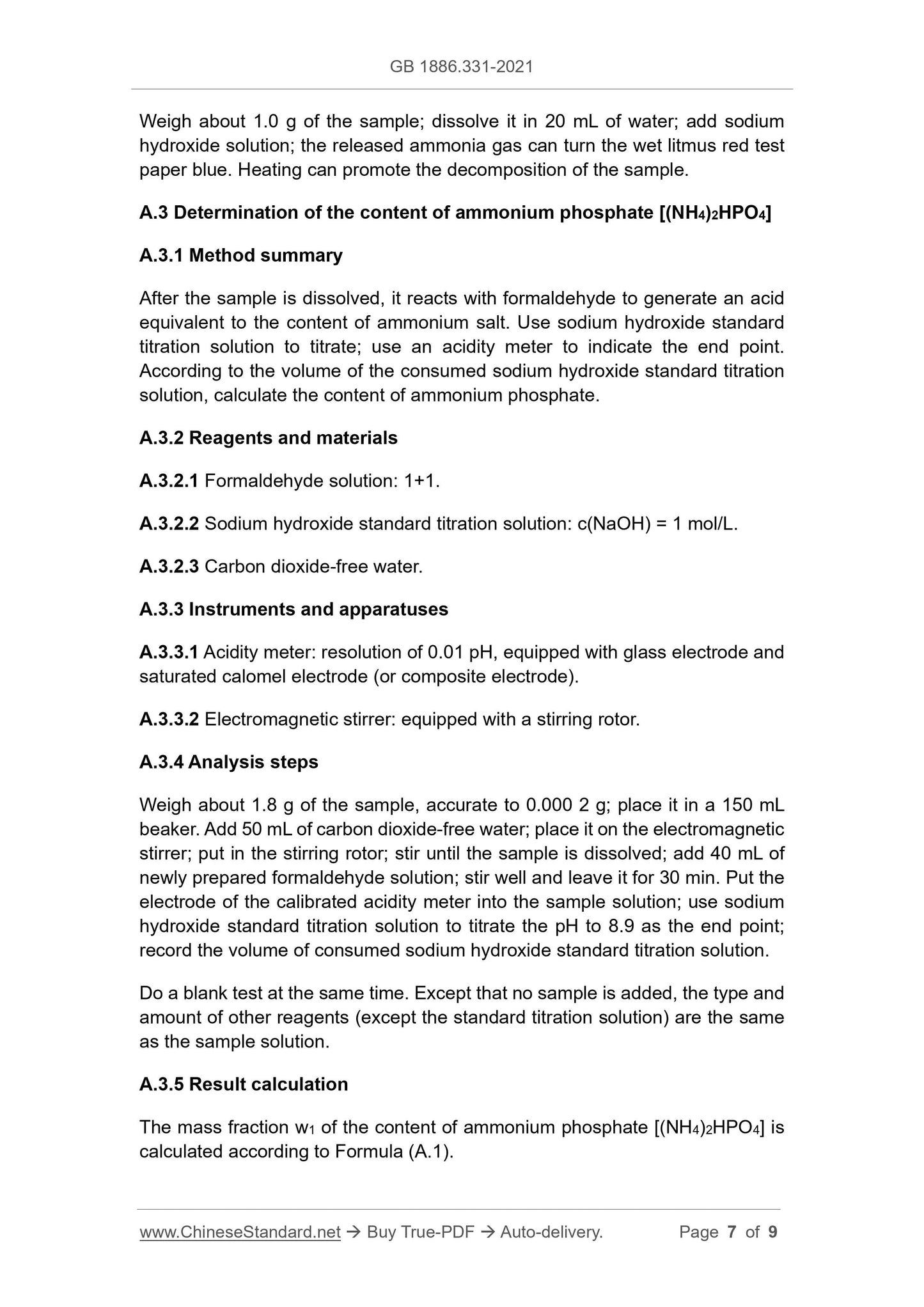1
/
of
5
PayPal, credit cards. Download editable-PDF & invoice in 1 second!
GB 1886.331-2021 English PDF (GB1886.331-2021)
GB 1886.331-2021 English PDF (GB1886.331-2021)
Regular price
$95.00 USD
Regular price
Sale price
$95.00 USD
Unit price
/
per
Shipping calculated at checkout.
Couldn't load pickup availability
Delivery: 3 seconds. Download true-PDF + Invoice.
Get QUOTATION in 1-minute: Click GB 1886.331-2021
Historical versions: GB 1886.331-2021
Preview True-PDF (Reload/Scroll if blank)
GB 1886.331-2021: National food safety standard - Food additives - Ammonium phosphate
GB 1886.331-2021
GB
NATIONAL STANDARD OF THE
PEOPLE’S REPUBLIC OF CHINA
National food safety standard - Food additives -
Ammonium phosphate
ISSUED ON: FEBRUARY 22, 2021
IMPLEMENTED ON: AUGUST 22, 2021
Issued by: National Health Commission of the People's Republic of
China;
State Administration for Market Regulation.
Table of Contents
Foreword ... 3
1 Scope ... 4
2 Molecular formula and relative molecular mass ... 4
3 Technical requirements ... 4
Appendix A Inspection method ... 6
National food safety standard - Food additives -
Ammonium phosphate
1 Scope
This Standard applies to the food additive ammonium phosphate that is
produced with liquid ammonia and the food additive phosphoric acid (including
wet-process phosphoric acid) as raw materials.
2 Molecular formula and relative molecular mass
2.1 Molecular formula
(NH4)2HPO4
2.2 Relative molecular mass
132.06 (according to the international relative atomic mass in 2018)
3 Technical requirements
3.1 Sensory requirements
Sensory requirements shall be in accordance with Table 1.
Table 1 – Sensory requirements
3.2 Physical and chemical indicators
Physical and chemical indicators shall be in accordance with Table 2.
Table 2 – Physical and chemical indicators
Appendix A
Inspection method
WARNING: Some reagents which are used in this test method are toxic or
corrosive, so, be careful when operating! If necessary, perform it in a fume
hood. If it is splashed on the skin, use water to rinse it immediately. If it is
serious, seek medical attention immediately.
A.1 General provisions
The reagents and water that are used in this Standard, when no other
requirements are specified, refer to analytical reagents and grade-III water
which is specified in GB/T 6682. The standard solutions, preparations and
products for impurity determination, which are used in the test, are all prepared
in accordance with the provisions of GB/T 601, GB/T 602, and GB/T 603, when
no other requirements are specified. The used solution, if not indicated which
solvent is used, refers to aqueous solution.
A.2 Identification test
A.2.1 Reagents and materials
A.2.1.1 Nitric acid solution: 1+8.
A.2.1.2 Ammonia solution: 1+1.
A.2.1.3 Sodium hydroxide solution: 40 g/L.
A.2.1.4 Silver nitrate solution: 17 g/L.
A.2.1.5 Litmus red test paper.
A.2.2 Identification method
A.2.2.1 Identification of phosphate ion
Weigh about 1.0 g of the sample; dissolve it in 20 mL of water; use nitric acid
solution to adjust the pH to neutral. Add silver nitrate solution, to produce a
yellow precipitate. This precipitate is soluble in ammonia solution or nitric acid
solution.
A.2.2.2 Identification of ammonium ion
Weigh about 1.0 g of the sample; dissolve it in 20 mL of water; add sodium
hydroxide solution; the released ammonia gas can turn the wet litmus red test
paper blue. Heating can promote the decomposition of the sample.
A.3 Determination of the content of ammonium phosphate [(NH4)2HPO4]
A.3.1 Method summary
After the sample is dissolved, it reacts with formaldehyde to generate an acid
equivalent to the content of ammonium salt. Use sodium hydroxide standard
titration solution to titrate; use an acidity meter to indicate the end point.
According to the volume of the consumed sodium hydroxide standard titration
solution, calculate the content of ammonium phosphate.
A.3.2 Reagents and materials
A.3.2.1 Formaldehyde solution: 1+1.
A.3.2.2 Sodium hydroxide standard titration solution: c(NaOH) = 1 mol/L.
A.3.2.3 Carbon dioxide-free water.
A.3.3 Instruments and apparatuses
A.3.3.1 Acidity meter: resolution of 0.01 pH, equipped with glass electrode and
saturated calomel electrode (or composite electrode).
A.3.3.2 Electromagnetic stirrer: equipped with a stirring rotor.
A.3.4 Analysis steps
Weigh about 1.8 g of the sample, accurate to 0.000 2 g; place it in a 150 mL
beaker. Add 50 mL of carbon dioxide-free water; place it on the electromagnetic
stirrer; put in the stirring rotor; stir until the sample is dissolved; add 40 mL of
newly prepared formaldehyde solution; stir well and leave it for 30 min. Put the
electrode of the calibrated acidity meter into the sample solution; use sodium
hydroxide standard titration solution to titrate the pH to 8.9 as the end point;
record the volume of consumed sodium hydroxide standard titration solution.
Do a blank test at the same time. Except that no sample is added, the type and
amount of other reagents (except the standard titration solution) are the same
as the sample solution.
A.3.5 Result calculation
The mass fraction w1 of the content of ammonium phosphate [(NH4)2HPO4] is
calculated according to Formula (A.1).
Get QUOTATION in 1-minute: Click GB 1886.331-2021
Historical versions: GB 1886.331-2021
Preview True-PDF (Reload/Scroll if blank)
GB 1886.331-2021: National food safety standard - Food additives - Ammonium phosphate
GB 1886.331-2021
GB
NATIONAL STANDARD OF THE
PEOPLE’S REPUBLIC OF CHINA
National food safety standard - Food additives -
Ammonium phosphate
ISSUED ON: FEBRUARY 22, 2021
IMPLEMENTED ON: AUGUST 22, 2021
Issued by: National Health Commission of the People's Republic of
China;
State Administration for Market Regulation.
Table of Contents
Foreword ... 3
1 Scope ... 4
2 Molecular formula and relative molecular mass ... 4
3 Technical requirements ... 4
Appendix A Inspection method ... 6
National food safety standard - Food additives -
Ammonium phosphate
1 Scope
This Standard applies to the food additive ammonium phosphate that is
produced with liquid ammonia and the food additive phosphoric acid (including
wet-process phosphoric acid) as raw materials.
2 Molecular formula and relative molecular mass
2.1 Molecular formula
(NH4)2HPO4
2.2 Relative molecular mass
132.06 (according to the international relative atomic mass in 2018)
3 Technical requirements
3.1 Sensory requirements
Sensory requirements shall be in accordance with Table 1.
Table 1 – Sensory requirements
3.2 Physical and chemical indicators
Physical and chemical indicators shall be in accordance with Table 2.
Table 2 – Physical and chemical indicators
Appendix A
Inspection method
WARNING: Some reagents which are used in this test method are toxic or
corrosive, so, be careful when operating! If necessary, perform it in a fume
hood. If it is splashed on the skin, use water to rinse it immediately. If it is
serious, seek medical attention immediately.
A.1 General provisions
The reagents and water that are used in this Standard, when no other
requirements are specified, refer to analytical reagents and grade-III water
which is specified in GB/T 6682. The standard solutions, preparations and
products for impurity determination, which are used in the test, are all prepared
in accordance with the provisions of GB/T 601, GB/T 602, and GB/T 603, when
no other requirements are specified. The used solution, if not indicated which
solvent is used, refers to aqueous solution.
A.2 Identification test
A.2.1 Reagents and materials
A.2.1.1 Nitric acid solution: 1+8.
A.2.1.2 Ammonia solution: 1+1.
A.2.1.3 Sodium hydroxide solution: 40 g/L.
A.2.1.4 Silver nitrate solution: 17 g/L.
A.2.1.5 Litmus red test paper.
A.2.2 Identification method
A.2.2.1 Identification of phosphate ion
Weigh about 1.0 g of the sample; dissolve it in 20 mL of water; use nitric acid
solution to adjust the pH to neutral. Add silver nitrate solution, to produce a
yellow precipitate. This precipitate is soluble in ammonia solution or nitric acid
solution.
A.2.2.2 Identification of ammonium ion
Weigh about 1.0 g of the sample; dissolve it in 20 mL of water; add sodium
hydroxide solution; the released ammonia gas can turn the wet litmus red test
paper blue. Heating can promote the decomposition of the sample.
A.3 Determination of the content of ammonium phosphate [(NH4)2HPO4]
A.3.1 Method summary
After the sample is dissolved, it reacts with formaldehyde to generate an acid
equivalent to the content of ammonium salt. Use sodium hydroxide standard
titration solution to titrate; use an acidity meter to indicate the end point.
According to the volume of the consumed sodium hydroxide standard titration
solution, calculate the content of ammonium phosphate.
A.3.2 Reagents and materials
A.3.2.1 Formaldehyde solution: 1+1.
A.3.2.2 Sodium hydroxide standard titration solution: c(NaOH) = 1 mol/L.
A.3.2.3 Carbon dioxide-free water.
A.3.3 Instruments and apparatuses
A.3.3.1 Acidity meter: resolution of 0.01 pH, equipped with glass electrode and
saturated calomel electrode (or composite electrode).
A.3.3.2 Electromagnetic stirrer: equipped with a stirring rotor.
A.3.4 Analysis steps
Weigh about 1.8 g of the sample, accurate to 0.000 2 g; place it in a 150 mL
beaker. Add 50 mL of carbon dioxide-free water; place it on the electromagnetic
stirrer; put in the stirring rotor; stir until the sample is dissolved; add 40 mL of
newly prepared formaldehyde solution; stir well and leave it for 30 min. Put the
electrode of the calibrated acidity meter into the sample solution; use sodium
hydroxide standard titration solution to titrate the pH to 8.9 as the end point;
record the volume of consumed sodium hydroxide standard titration solution.
Do a blank test at the same time. Except that no sample is added, the type and
amount of other reagents (except the standard titration solution) are the same
as the sample solution.
A.3.5 Result calculation
The mass fraction w1 of the content of ammonium phosphate [(NH4)2HPO4] is
calculated according to Formula (A.1).
Share
